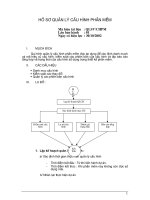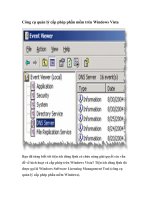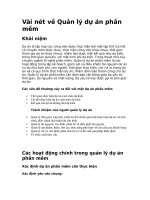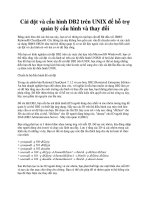Quản lý cấu hình phần mềm
Bạn đang xem bản rút gọn của tài liệu. Xem và tải ngay bản đầy đủ của tài liệu tại đây (553.91 KB, 52 trang )
Configuration management
Quản lý Cấu hình Phần mềm
Objectives
• To explain the importance of software
configuration management (CM)
• To describe key CM activities namely CM
planning, change management, version
planning, change management, version
management and system building
• To discuss the use of CASE tools to support
configuration management processes
Topics covered
• Configuration management planning
• Change management
• Version and release management
•
System building
•
System building
• CASE tools for configuration management
Configuration management
• New versions of software systems are created
as they change:
– For different machines/OS;
– Offering different functionality;
–
Tailored for particular user requirements.
–
Tailored for particular user requirements.
• Configuration management is concerned with
managing evolving software systems:
– System change is a team activity;
– CM aims to control the costs and effort involved in
making changes to a system.
Configuration management
• Involves the development and application of
procedures and standards to manage an
evolving software product.
•
CM may be seen as part of a more general
•
CM may be seen as part of a more general
quality management process.
• When released to CM, software systems are
sometimes called baselines as they are a
starting point for further development.
System families
CM standards
• CM should always be based on a set of standards
which are applied within an organisation.
• Standards should define how items are identified,
how changes are controlled and how new versions
how changes are controlled and how new versions
are managed.
• Standards may be based on external CM standards
(e.g. IEEE standard for CM).
• Some existing standards are based on a waterfall
process model - new CM standards are needed for
evolutionary development.
Concurrent development and
testing
• A time (say 2pm) for delivery of system
components is agreed.
• A new version of a system is built from these
components by compiling and linking them.
components by compiling and linking them.
• This new version is delivered for testing using
pre-defined tests.
• Faults that are discovered during testing are
documented and returned to the system
developers.
Frequent system building
• It is easier to find problems that stem from
component interactions early in the process.
• This encourages thorough unit testing -
developers are under pressure not to ‘break
developers are under pressure not to ‘break
the build’.
• A stringent change management process is
required to keep track of problems that have
been discovered and repaired.
CM planning
• All products of the software process may have
to be managed:
– Specifications;
–
Designs;
–
Designs;
– Programs;
– Test data;
– User manuals.
• Thousands of separate documents may be
generated for a large, complex software
system.
The CM plan
• Defines the types of documents to be
managed and a document naming scheme.
• Defines who takes responsibility for the CM
procedures and creation of baselines.
procedures and creation of baselines.
• Defines policies for change control and version
management.
• Defines the CM records which must be
maintained.
The CM plan
• Describes the tools which should be used to
assist the CM process and any limitations on
their use.
•
Defines the process of tool use.
•
Defines the process of tool use.
• Defines the CM database used to record
configuration information.
• May include information such as the CM of
external software, process auditing, etc.
Configuration item identification
• Large projects typically produce thousands of
documents which must be uniquely identified.
• Some of these documents must be maintained for
the lifetime of the software.
the lifetime of the software.
• Document naming scheme should be defined
so that related documents have related names.
• A hierarchical scheme with multi-level names is
probably the most flexible approach.
– PCL-TOOLS/EDIT/FORMS/DISPLAY/AST-INTERFACE/CODE
Configuration hierarchy
The configuration database
• All CM information should be maintained in a
configuration database.
• This should allow queries about configurations to be
answered:
answered:
– Who has a particular system version?
– What platform is required for a particular version?
– What versions are affected by a change to component X?
– How many reported faults in version T?
• The CM database should preferably be linked to the
software being managed.
CM database implementation
• May be part of an integrated environment to support
software development.
– The CM database and the managed documents are all
maintained on the same system
•
CASE tools may be integrated with this so that there
•
CASE tools may be integrated with this so that there
is a close relationship between the CASE tools and
the CM tools.
• More commonly, the CM database is maintained
separately as this is cheaper and more flexible.
Change management
• Software systems are subject to continual
change requests:
– From users;
–
From developers;
–
From developers;
– From market forces.
• Change management is concerned with
keeping track of these changes and ensuring
that they are implemented in the most cost-
effective way.
The change management process
Request change by completing a change request form
Analyze change request
if change is valid
then
Assess how change might be implemented
Assess change cost
Submit request to change control board
if
change is accepted
then
if
change is accepted
then
repeat
make changes to software
submit changed software for quality approval
until software quality is adequate
create new system version
else
reject change request
else
reject change request
Change request form
• The definition of a change request form is part of the
CM planning process.
• This form records the change proposed, requestor of
change, the reason why change was suggested and
change, the reason why change was suggested and
the urgency of change(from requestor of the
change).
• It also records change evaluation, impact analysis,
change cost and recommendations (System
maintenance staff).
Change request form
Change tracking tools
• A major problem in change management is
tracking change status.
• Change tracking tools keep track the status of
each change request and automatically ensure
each change request and automatically ensure
that change requests are sent to the right
people at the right time.
• Integrated with E-mail systems allowing
electronic change request distribution.
Change control board
• Changes should be reviewed by an external group
who decide whether or not they are cost-effective
from a strategic and organizational viewpoint rather
than a technical viewpoint.
• Should be independent of project responsible
for system. The group is sometimes called a change
control board.
• The CCB may include representatives from client and
contractor staff.
Derivation history
• This is a record of changes applied to a
document or code component.
• It should record, in outline, the change made,
the rationale for the change, who made the
the rationale for the change, who made the
change and when it was implemented.
• It may be included as a comment in code. If a
standard prologue style is used for the
derivation history, tools can process this
automatically.
Component header information
// BANKSEC project (IST 6087)
//
// BANKSEC-TOOLS/AUTH/RBAC/USER_ROLE
//
// Object: currentRole
/
/ A
u
t
h
o
r
:
N
. P
e
r
wa
i
z
/
/ A
u
t
h
o
r
:
N
. P
e
r
wa
i
z
// Creation date: 10th November 2002
//
// © Lancaster University 2002
//
// Modification history
// Version ModifierDate Change Reason
// 1.0 J. Jones 1/12/2002 Add header Submitted to CM
// 1.1 N. Perwaiz 9/4/2003New field Change req. R07/02
Version and release management
• Invent an identification scheme for system
versions.
• Plan when a new system version is to be
produced.
produced.
• Ensure that version management procedures
and tools are properly applied.
• Plan and distribute new system releases.









